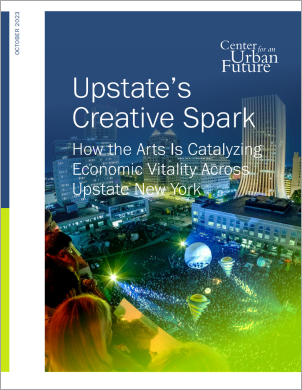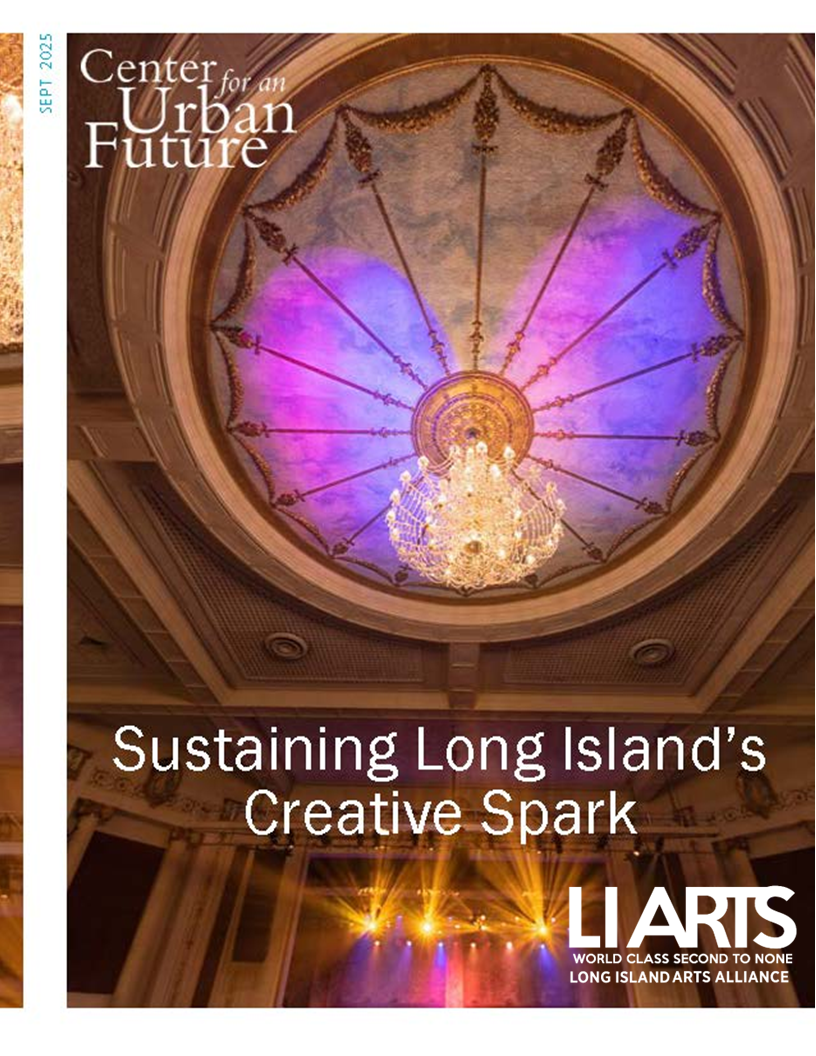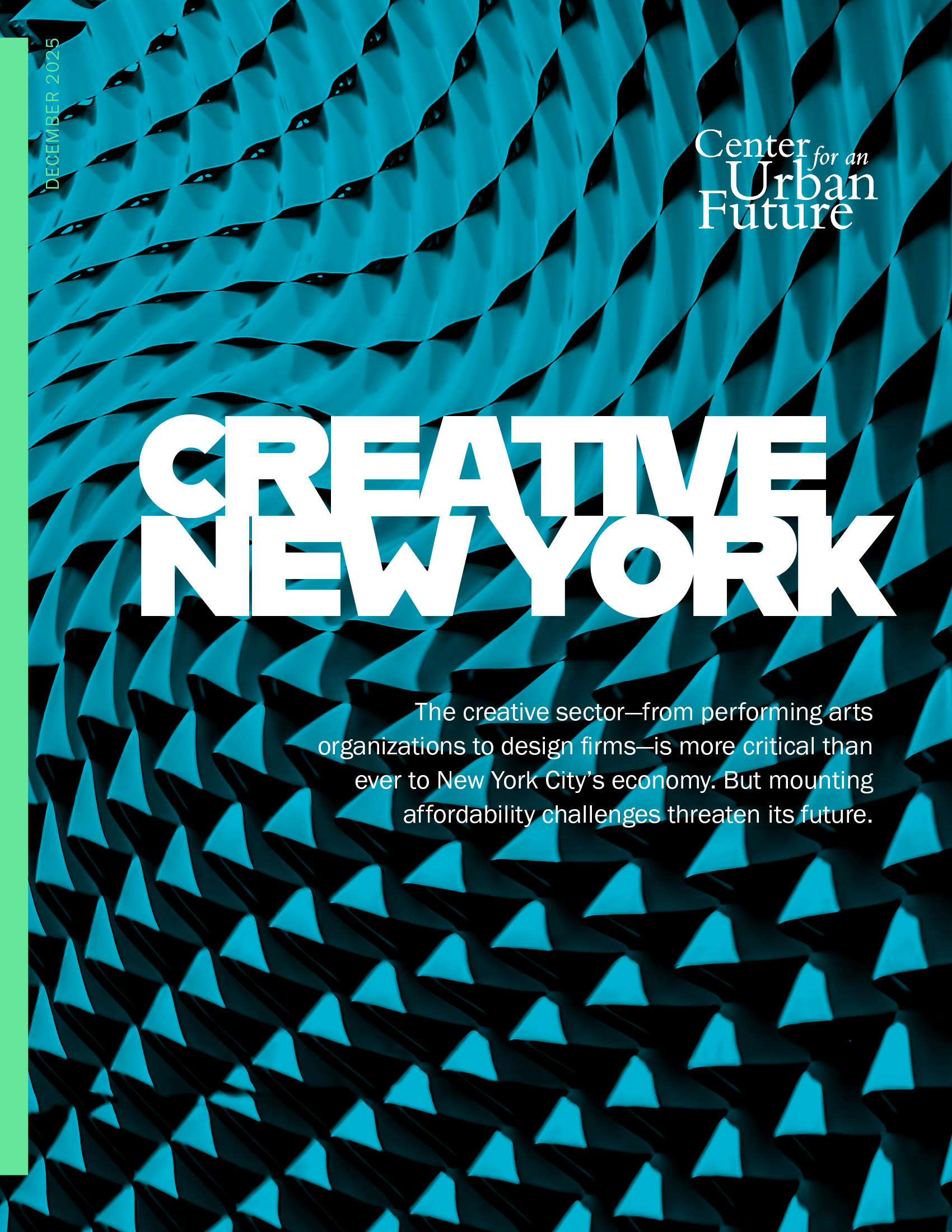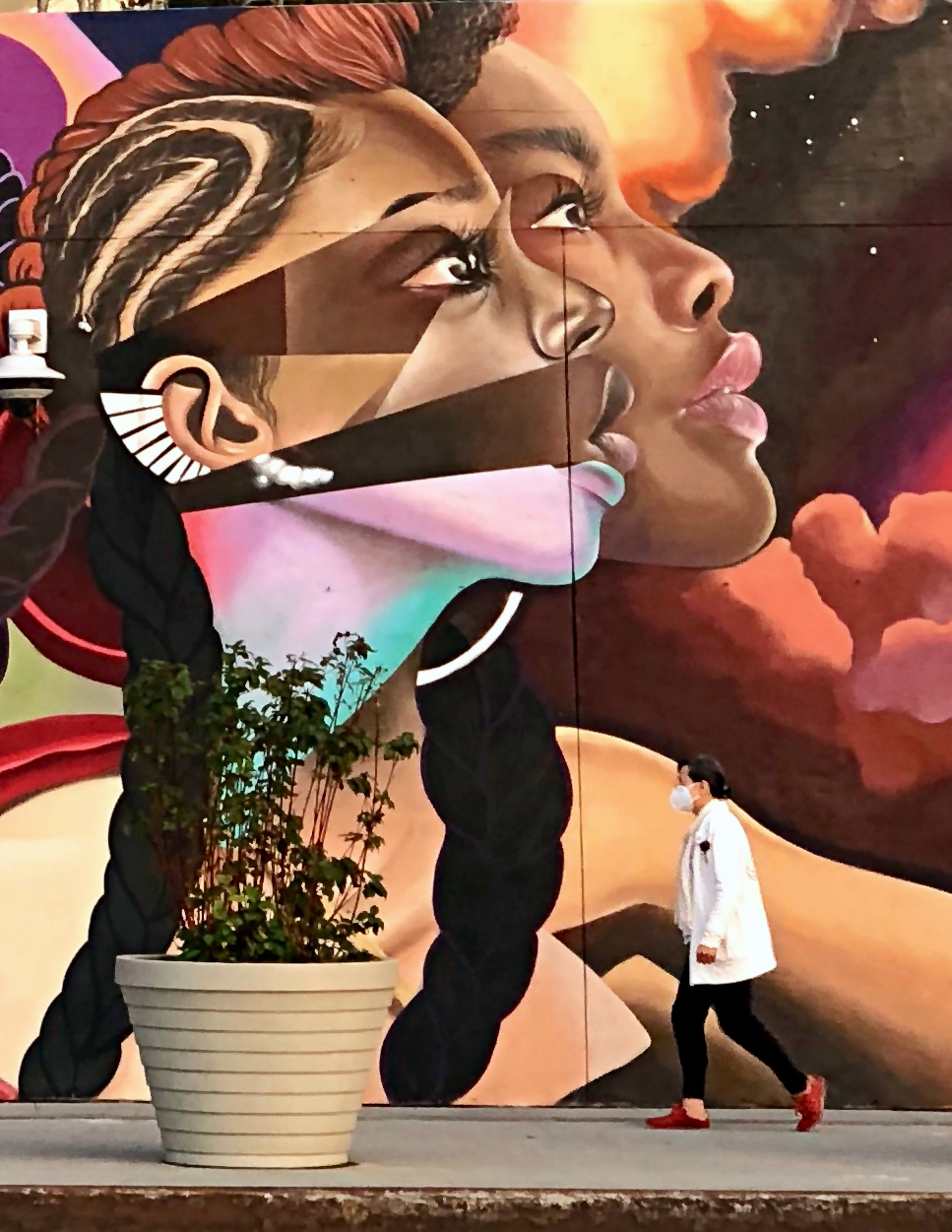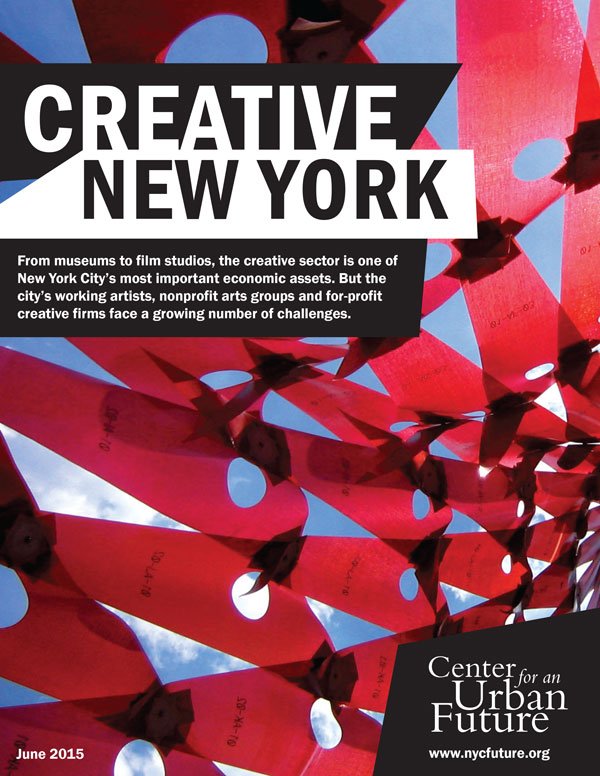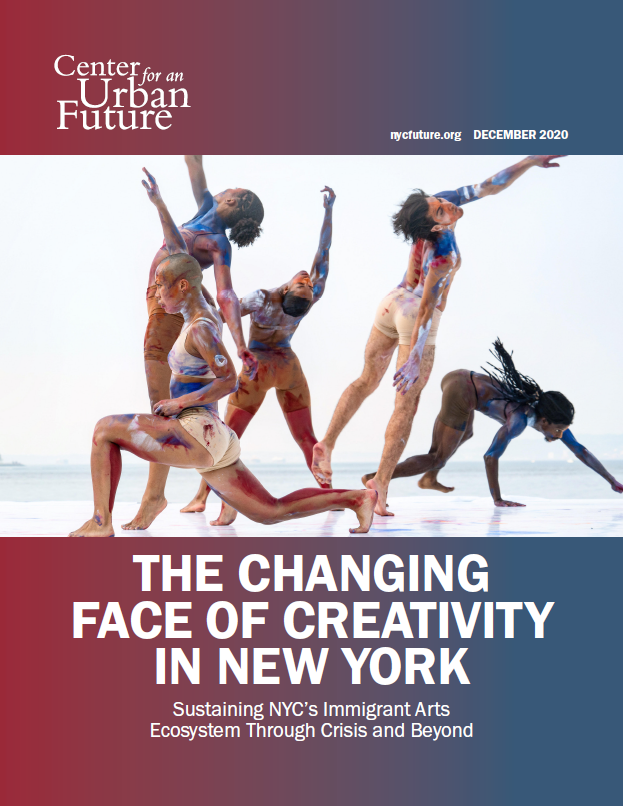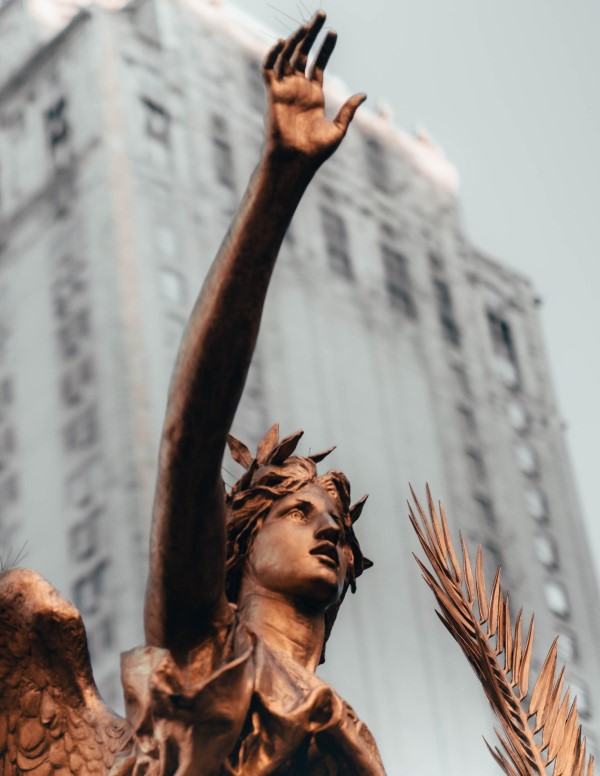The Power of the Arts to Revitalize New York
Reviving the fortunes of upstate New York has been a major economic development priority of governors and legislators since at least the 1990s. During this time, state policymakers have rolled out an array of strategies, development projects, and financial incentives designed to reverse decades of economic stagnation and population declines—and foster new investment in hard-hit downtown areas. While some of these public initiatives have produced results, few have had as powerful an economic and social impact on upstate communities as another far less appreciated catalyst: the arts.
Employment in the arts and culture sector across upstate New York surged 35 percent from 2009 to 2019, nearly 10 times the overall rate of employment growth upstate (4 percent) and three times the growth rate of the healthcare sector (12 percent).1 This employment boom occurred in nearly every corner of the state, with striking arts sector job growth in Buffalo (59 percent), Syracuse (53.5 percent), Albany (33 percent), and Rochester (14 percent), and across regions including the Hudson Valley (48 percent), Southern Tier (36.5 percent), North Country (28.5 percent), and Capital Region (21 percent).2
In addition, artists have been fueling much of the population growth in upstate communities. At a time when many upstate cities have seen little overall population growth—and when the under-65 population has been in rapid decline in most communities—the number of working artists in upstate New York increased by 26.5 percent between 2011 and 2021.3 This influx of artists and homegrown talent—and the accompanying revival of art galleries, festivals, theaters, concert halls, and museums—has helped reinvigorate downtown communities, drive tourism, and spark the creation of new restaurants, coffee shops, and other small businesses.
But this impact could be so much more. Indeed, the growth in artists and arts-related employment has occurred in spite of declining levels of public investment in the arts across upstate New York. The primary grantmaking budget for the New York State Council on the Arts (NYSCA), the state’s primary arts funding mechanism, fell from $63.1 million in FY 2008 to $40.6 million today—a 35.6 percent decline, after adjusting for inflation—and is now 68 percent below its 1990 peak. Fortunately, Governor Hochul and the state legislature have stepped up non-recurring state funding to NYSCA to partially offset the loss of federal relief dollars; still, the total grantmaking budget will decline compared to FY 2023.4
At the same time, even though the arts sector has been an engine of economic opportunity, the state’s economic development tools—from the Regional Economic Development Councils (REDCs), to the Downtown Revitalization Initiative (DRI), to Market New York’s tourism grant program—too often overlook it. In 2021, upstate REDCs only awarded 3.7 percent of all grants to projects related to arts and culture. Likewise, just 12 out of the 104 DRI projects across all of New York State in 2022, or 11.5 percent, were related to arts and culture.5
While New York has barely begun to harness the full potential of the arts in upstate communities, there are also several emerging challenges that could dampen future growth in this increasingly vital part of the economy. As rents and property costs skyrocket in many communities, artists and arts groups face growing concerns about being priced out of the places they have helped revitalize. Highly competitive operating grants haven’t nearly kept pace with inflation, leaving many nonprofits operating on shoestring budgets with few, if any, full-time employees. And in many places, critical arts infrastructure like arts councils, arts districts, and nonprofits that support artists are underfunded or missing altogether.
Where other economic development initiatives have seen mixed results in helping upstate New York overcome decades of underinvestment, job loss, and population decline, the under-the-radar arts sector has provided a much-needed economic jolt and created new opportunities for inclusive growth. By better integrating the arts into New York State economic development planning, policymakers have an opportunity to build on recent momentum and lay the groundwork for a more vibrant, sustainable, and equitable economy.
----
This report details the economic impact of the arts in upstate New York and the challenges the sector faces as pandemic-era funding dwindles. It also advances ten recommendations for how state and local policymakers can better support working artists and arts organizations in New York. Supported by a grant from the Rochester Area Community Foundation, the report builds on the Center for an Urban Future’s previous research on New York’s arts and culture sector and broader creative economy, including the 2021 report Creative Comeback: Surveying NYC’s Arts Ecosystem in the Wake of COVID-19 and the 2015 report Creative New York. It was informed by extensive data analysis and interviews with over 90 New Yorkers, including directors of arts and cultural organizations, individual artists, leaders of local and regional economic and community development organizations, small business owners, community leaders, and government officials, among many others.
Without the attention or investment afforded many other sectors, the arts have become a leading driver of economic opportunity across the state, sparking a new sense of possibility and hometown pride. In places that had been struggling to develop a post-industrial identity and stave off population decline, new and newly revitalized concert halls, galleries, theaters, murals and more have helped reanimate once-empty streets and draw new visitors and residents alike.
“Arts and culture have a way of revitalizing communities that I don’t think there’s any equivalent to. We’ve seen it throughout the state,” says Tim Weidemann, director of Ulster County’s department of economic development.
New data analysis by the Center for an Urban Future reveals that upstate New York’s resident artist population has expanded in cities and counties across the state in recent years, helping to counter decades of population losses among residents under age 65. The total population of art and design workers upstate grew from 10,747 in 2011 to 13,596 in 2021, a 26.5 percent increase. The growth of the resident artist population has outpaced total population growth in nearly every major city in the state, including Buffalo, Syracuse, and Rochester. In Albany, the resident artist population grew 50 percent, while the total population increased just 3 percent. In Buffalo, the resident artist population grew 45.3 percent, while the total population rose only 2.4 percent. (The 26.5 percent jump in the resident artist population upstate was also double the rate of growth of working artists in New York City.)6
In addition to welcoming more recent arrivals, cities and towns upstate are also seeing more young artists who grew up or earned degrees locally decide to put down roots. “We’ve absolutely seen a change in the way young people think about this city,” observes Bleu Cease, the executive director of the Rochester Contemporary Art Center. “The sentiment is no longer that graduates of the surrounding colleges and universities with arts programs are leaving for major metros. On a weekly basis, I meet artists who have decided to stay here.” Albany-based visual designer, arts educator, and activist Jade Warrick, who returned to her hometown from Los Angeles, says that more artists in the area are asking themselves, “Why do I need to leave my community to make the art I want to make?”
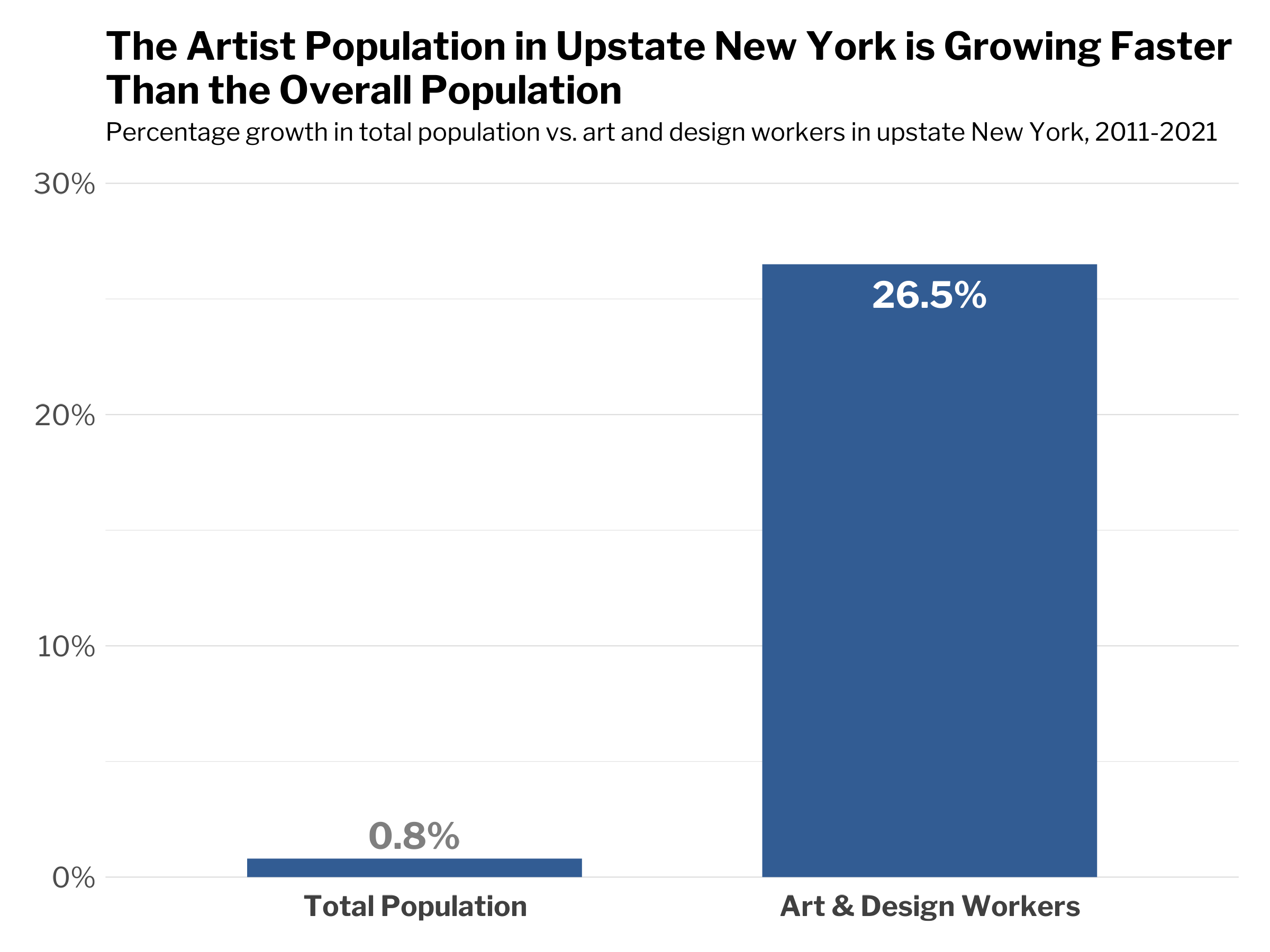
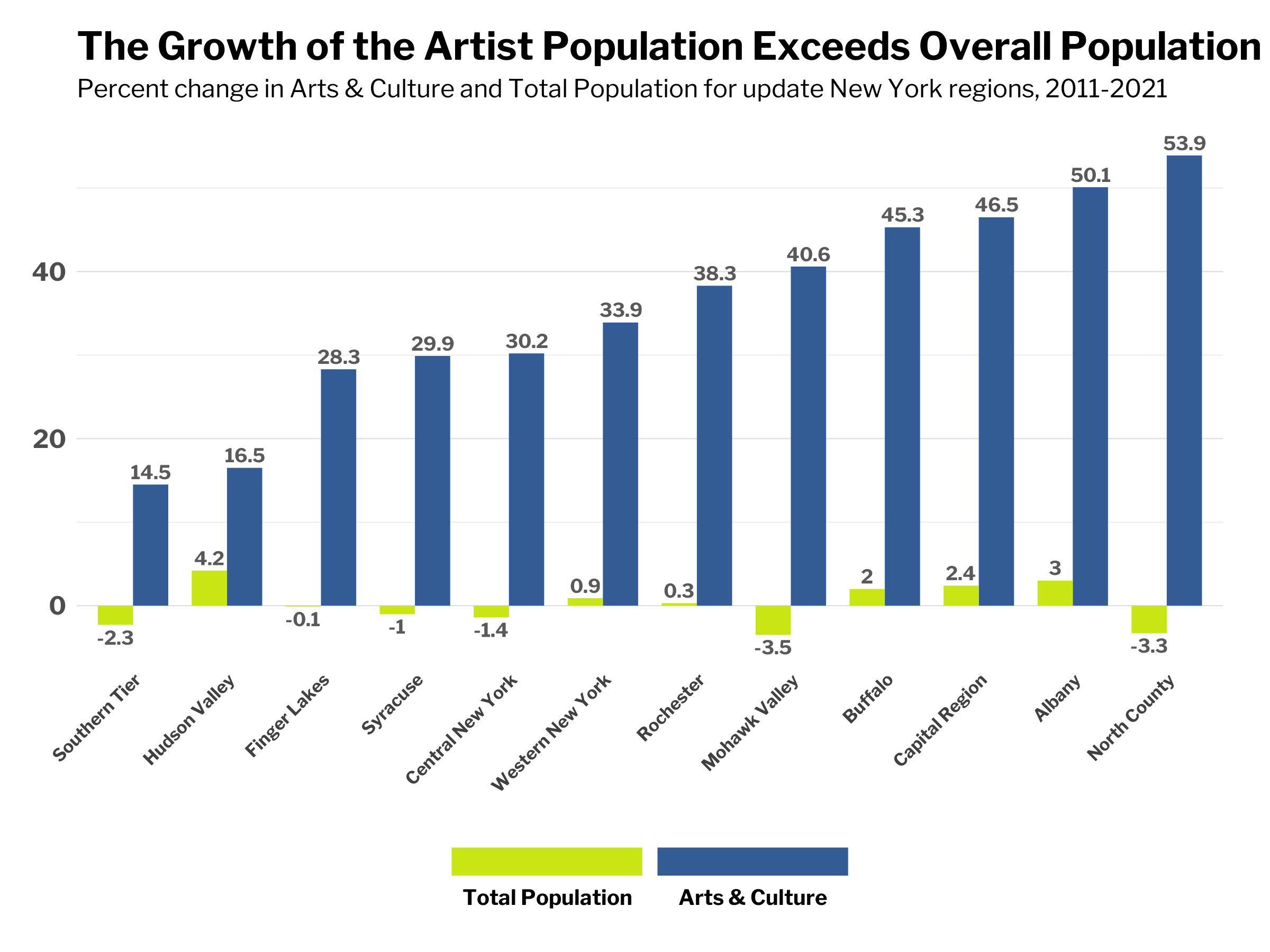
Many of these artists and the organizations that support them have seized on upstate New York’s abundance of underused buildings and public spaces to create new events and community hubs. The Rochester Fringe Festival has become one of the three biggest fringe festivals in the country since its 2012 debut in the city’s Martin Luther King Jr. Park, “which hadn’t been used [for public programming] for 20 years,” remembers the festival’s CEO and producer Erica Fee. ArtPort Kingston, established in 2019, brought contemporary art to neglected historic buildings on the waterfront, along with 350 visitors per weekend even during the pandemic—more than half of them exploring the area for the first time. In Buffalo, K Art Gallery brought contemporary Indigenous art to a 19th-century brownstone, while Assembly House 150 transformed an abandoned church into an interactive workshop and exhibition space.
Artists have seeded new organizations for communities historically deprived of arts programming. Avenue Blackbox Theatre became the first fully programmed performing arts venue in Rochester’s northeast quadrant when it opened its doors in 2018, and has since promoted a former teen fellow into a full-time employee. In 2019, the The Art Effect opened a youth-led gallery space in a neglected Poughkeepsie neighborhood and started a curatorial training program for youth from low-income backgrounds. In 2020, The Black Arts Collective began presenting arts and professional development programming in Syracuse, nurturing a community of Black curators, artists, and performers.
Meanwhile, once-grand, long-neglected theaters up and down the state have been revived, from Proctors Theater in Schenectady, which restored its Vaudeville-era architectural details in 2015, to the Landmark Theatre in Syracuse, which underwent a $2.4 million renovation in 2021. Anchor institutions including The Pines@SPAC in Saratoga and the Ulster Performing Arts Center in Kingston have also undergone major renovations, and several communities are banking on ambitious new and expanded cultural institutions to boost quality of life and drive regional tourism, from the new David Rockefeller Creative Arts Center at the Pocantico Center in Tarrytown to the expansion of Storm King Art Center in the Hudson Valley to the reimagining of an Adirondack amusement park into a campus for the arts.
The economic impact—and promise—of the upstate arts renaissance is clear. Between 2009 and 2019, employment growth in the arts and culture sector— including arts and culture venues, theater and dance companies, museums, musical groups, art schools, and independent artists—increased by 34.8 percent, outpacing a range of other industries, from educational services (11.9 percent) and healthcare (11.7 percent), to retail (-2 percent) and manufacturing (-6.3 percent).
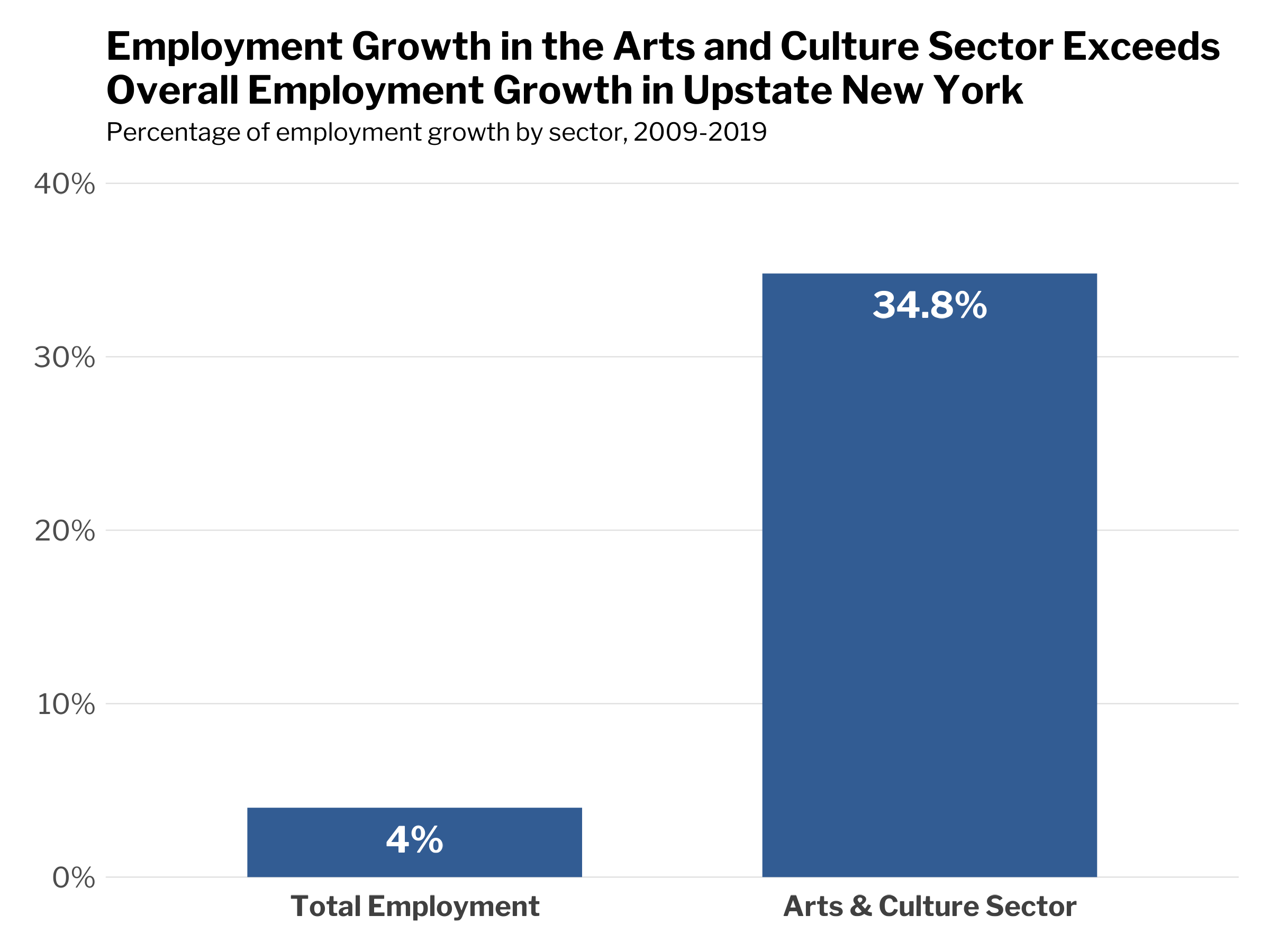
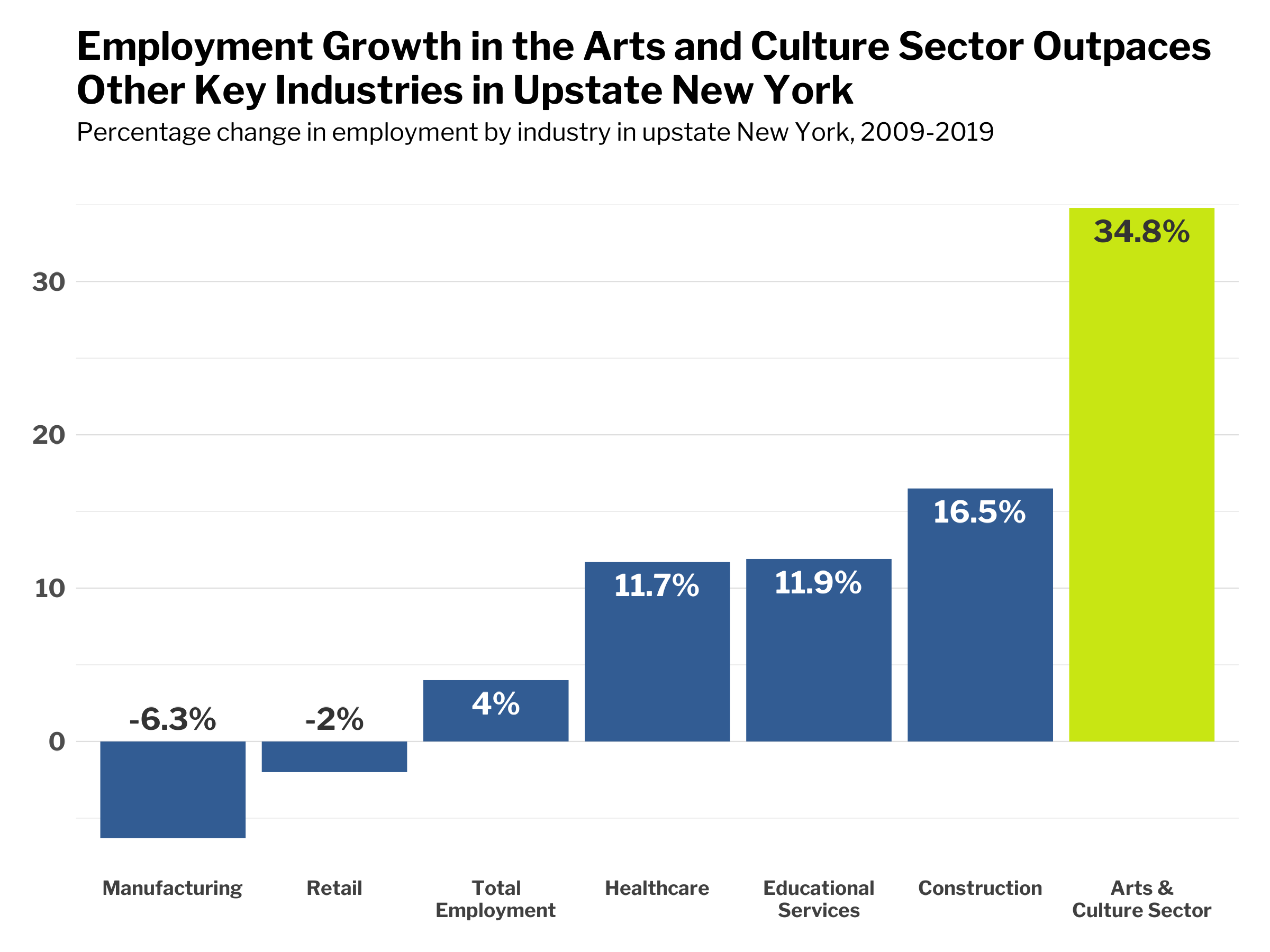
Though the pandemic hit the sector especially hard, arts and culture employment is up 11 percent since the low of 2020, with particularly remarkable rebounds in the Mohawk Valley (13.5 percent), Buffalo (12.8), the Capital Region (12 percent), and Rochester (10.7 percent).7
The arts have also been a major factor in the growth of tourism upstate, which has contributed to employment growth in a range of tourism-related industries. Between 2009 and 2019, employment in the accommodation and restaurant industries grew by 33.2 percent and 18.2 percent respectively, with tourist spending jumping by 51.1 percent in the same period, from $13 to $19.6 billion.8
The influx of visitors and locals alike are reanimating downtown streets that, in the 1990s and early aughts, were often empty—especially after 5 p.m. and on the weekends. “We have genuine feet on the street, here to enjoy what the city has to offer, all because of the arts,” says Jeff Buell, principal at Redburn Development Partners, which recently rehabilitated eight buildings in downtown Albany that had been vacant for nearly a decade.
Restaurants, retailers, and a wide variety of other small businesses have reaped the benefits. “We’re usually booked solid right before a show [at Tarrytown Music Hall],” says David Starkey, the owner of the Sweet Grass Grill, which serves local, seasonal food across the street from the venue. The Native Eatery and Bar in Rochester serves up to 50 percent more diners when there’s a performance at the Geva Theater, while Phoebe’s Restaurant estimates their profits grow by 75 percent when something’s on at Syracuse Stage.
Bigger businesses from out of town are also taking note of reanimated downtowns. On a visit to Syracuse in 2022, executives from the computer chip manufacturer Micron Technology spotted the restored marquee at the Landmark Theater announcing a soldout show. “The vibe downtown that night impressed them,” recalls Kevin Younis, the executive deputy commissioner of Empire State Development, the umbrella organization for New York’s two principal economic development entities. Confident that Syracuse could attract and retain workers, Micron soon announced a $100-billion commitment to build a mega-complex there, which is slated to create 9,000 jobs.
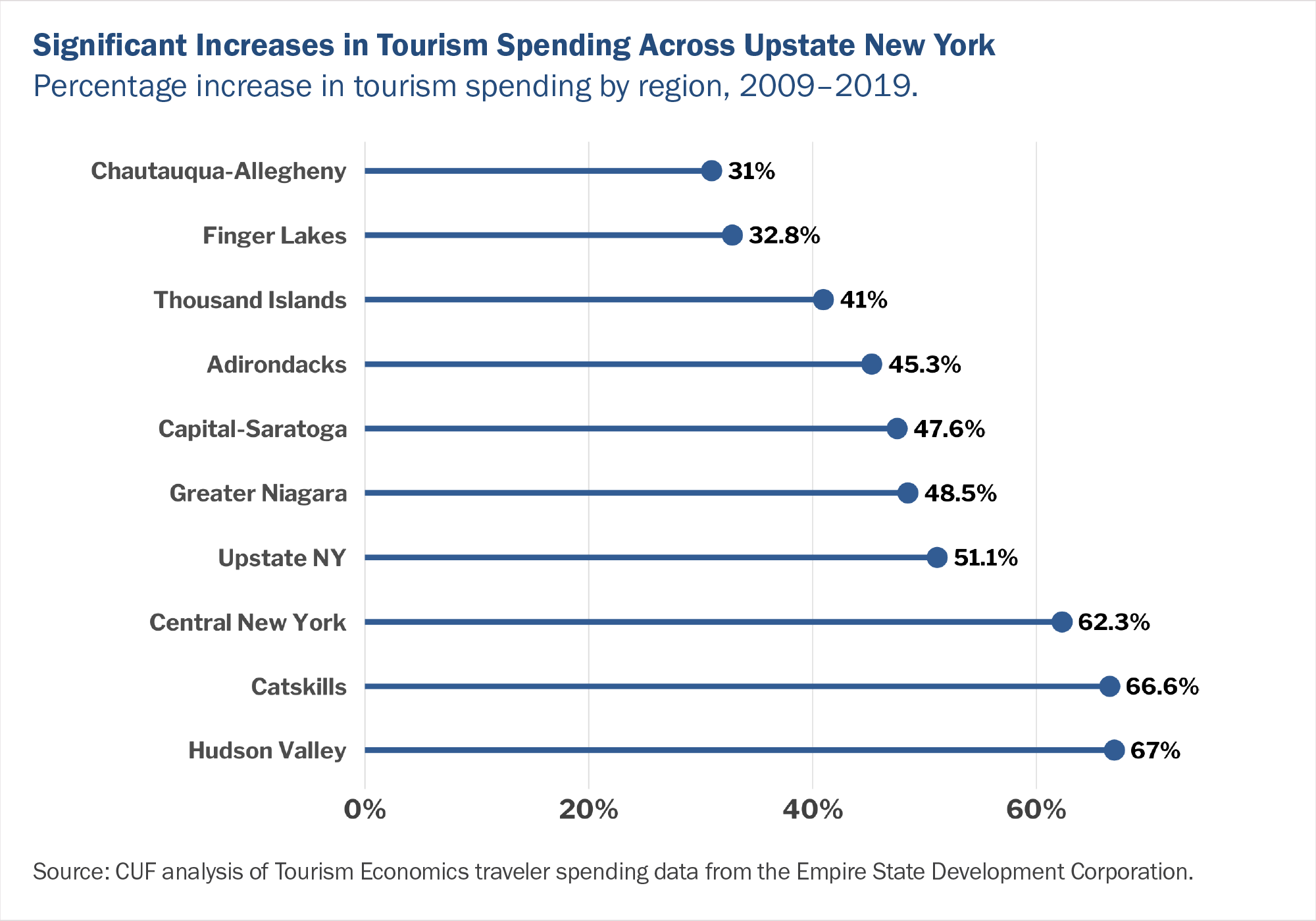
The value of the arts upstate, however, can hardly be reduced to its economic impact. Artists and art organizations are working to knit together a stronger social fabric—one that has been frayed by the COVID-19 pandemic. “The arts are intrinsic to community healing,” says Cjala Surratt, one of the co-founders of the Black Artist Collective in Syracuse. In cities, towns, and rural areas, artists are helping communities recover, forging links between generations, engaging youth in ways that ignite their passions, fostering dialogue about social justice issues, and creating spaces and occasions for neighbors to connect. “One of our central functions is building community,” says Christopher Mannelli, producing director of the Geva Theater in Rochester. “The arts allow connections to happen in a society that feels so divided.”
Arts funding has struggled to keep pace.
Despite the enormous potential for the arts to continue driving economic opportunity, improving quality of life, and strengthening communities across every corner of New York State, public support for the sector is extremely limited—and it has declined in recent decades.
While NYSCA continues to be an essential source of funding for artists across the state, its primary grantmaking budget has declined 35.6 percent between 2008 and 2023, and a whopping 68 percent since 1990, after adjusting for inflation—from $128 to $40.6 million in FY 2024. While Governor Hochul and the state legislature directed $90 million in crucial recovery funds for the arts sector in FY2022 and FY2023—stabilizing organizations reeling from the loss of audiences and revenues and creating transformational new initiatives—and stepped up additional one-time funding in FY2024, this level of support will need to become permanent going forward in order to secure the gains achieved since the depths of the pandemic, ensure a full recovery for the arts and culture sector, and lay the foundation for a stronger and more equitable arts ecosystem in the future.
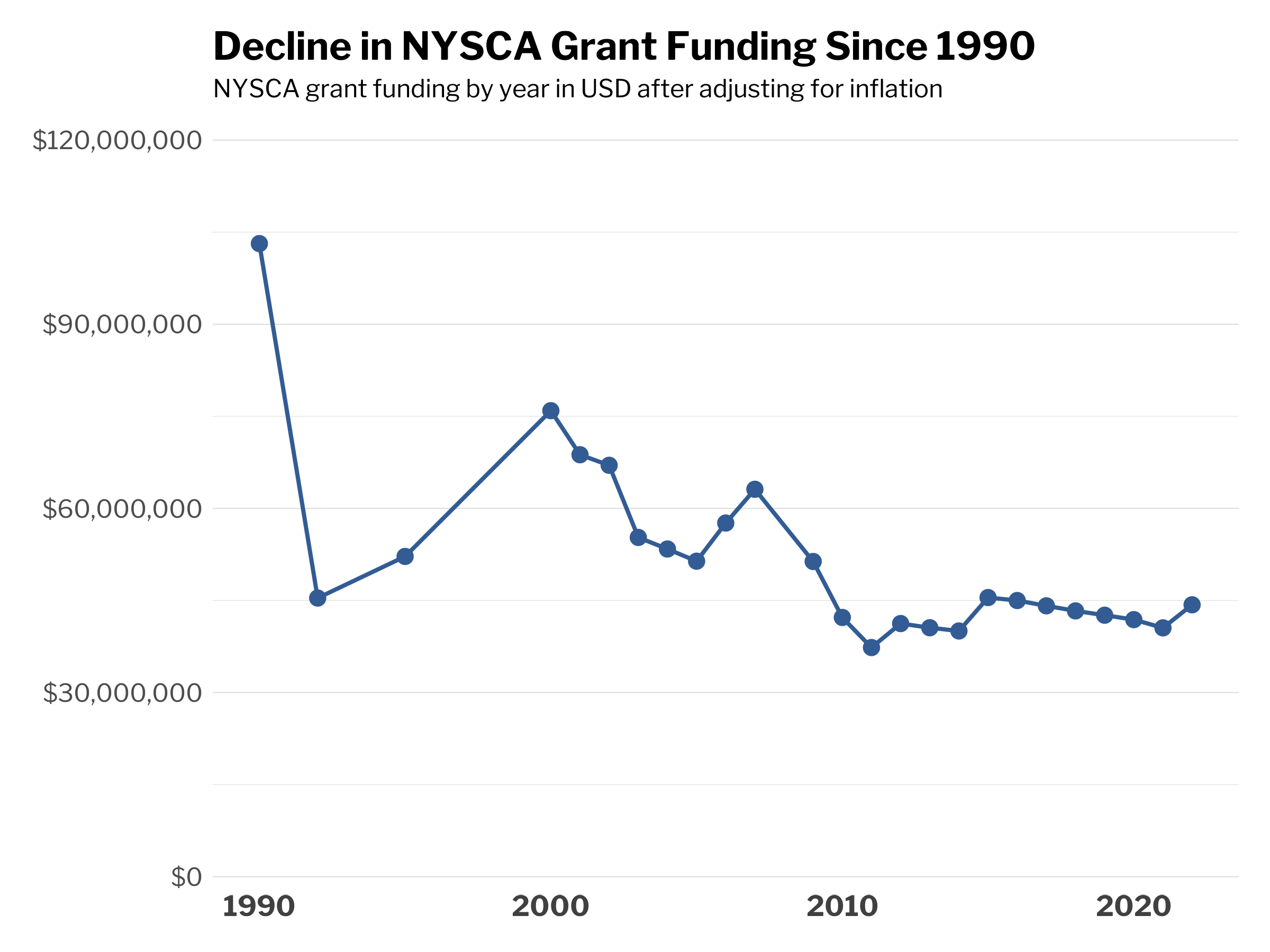
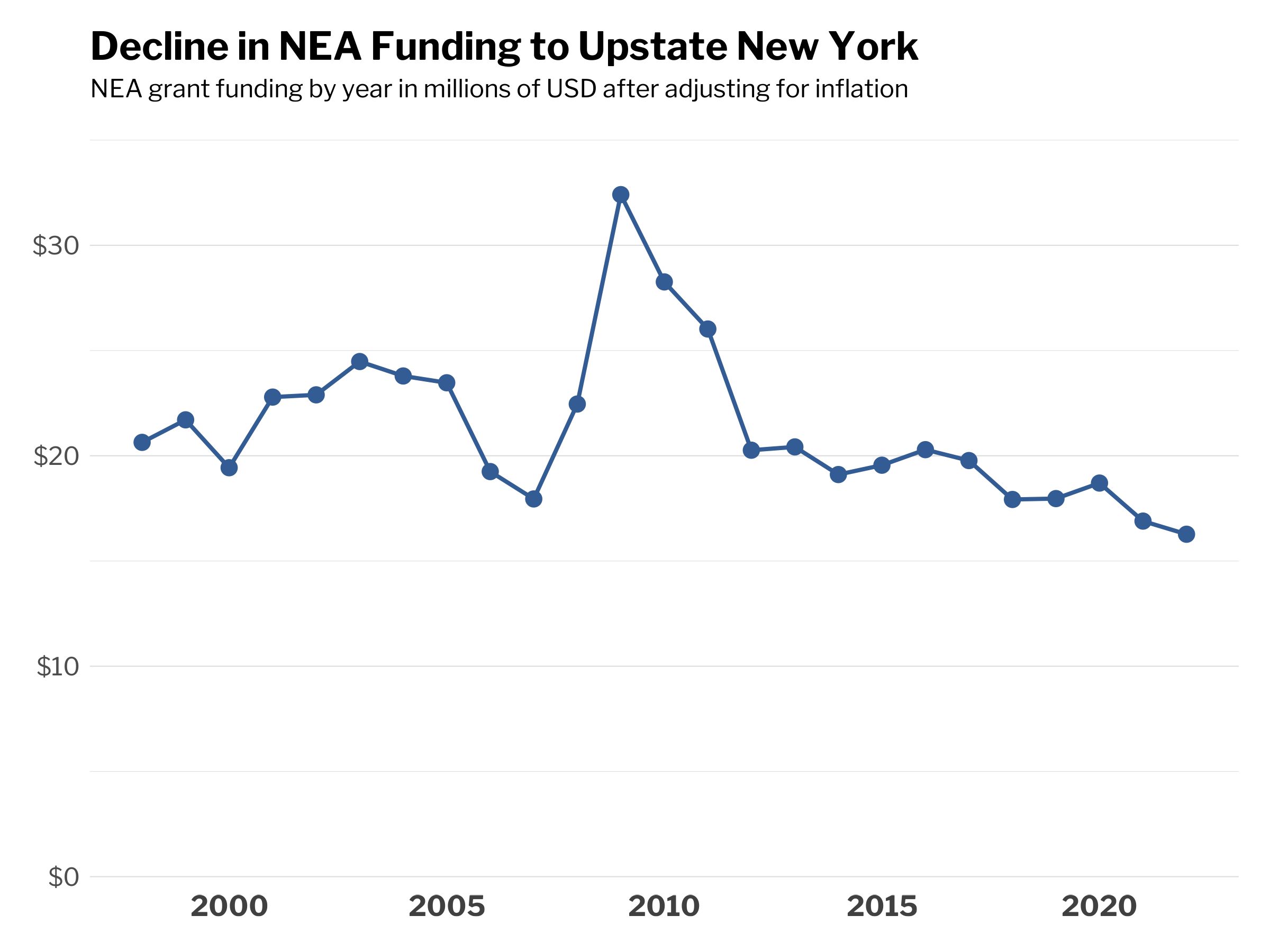
Counties and municipalities have struggled as much as ever to fund the arts. The city of Syracuse, for example, invested only $3,500 in arts and culture funding in the most recent fiscal year, and the entire sum was earmarked to one organization. “We receive absolutely no county funding. We receive no municipal funding from any of the towns or the one city in our county,” says the leader of one county arts council in a largely rural area.
Federal support for the arts has also been on the decline. Excluding the recent pandemic-related stimulus, since 1998, inflation-adjusted National Endowment for the Arts (NEA) grant funding to New York State declined 21.2 percent between 1998 and 2022, from $20.6 million to $16.3 million. NEA funding to organizations and artists in upstate New York has trended downward as well, decreasing 1.8 percent since 1998 after adjusting for inflation. In the same period, significant decreases in inflation-adjusted NEA funding were felt in Albany (-67.6 percent), Syracuse (-56.8 percent), and Rochester (-47.2 percent).9
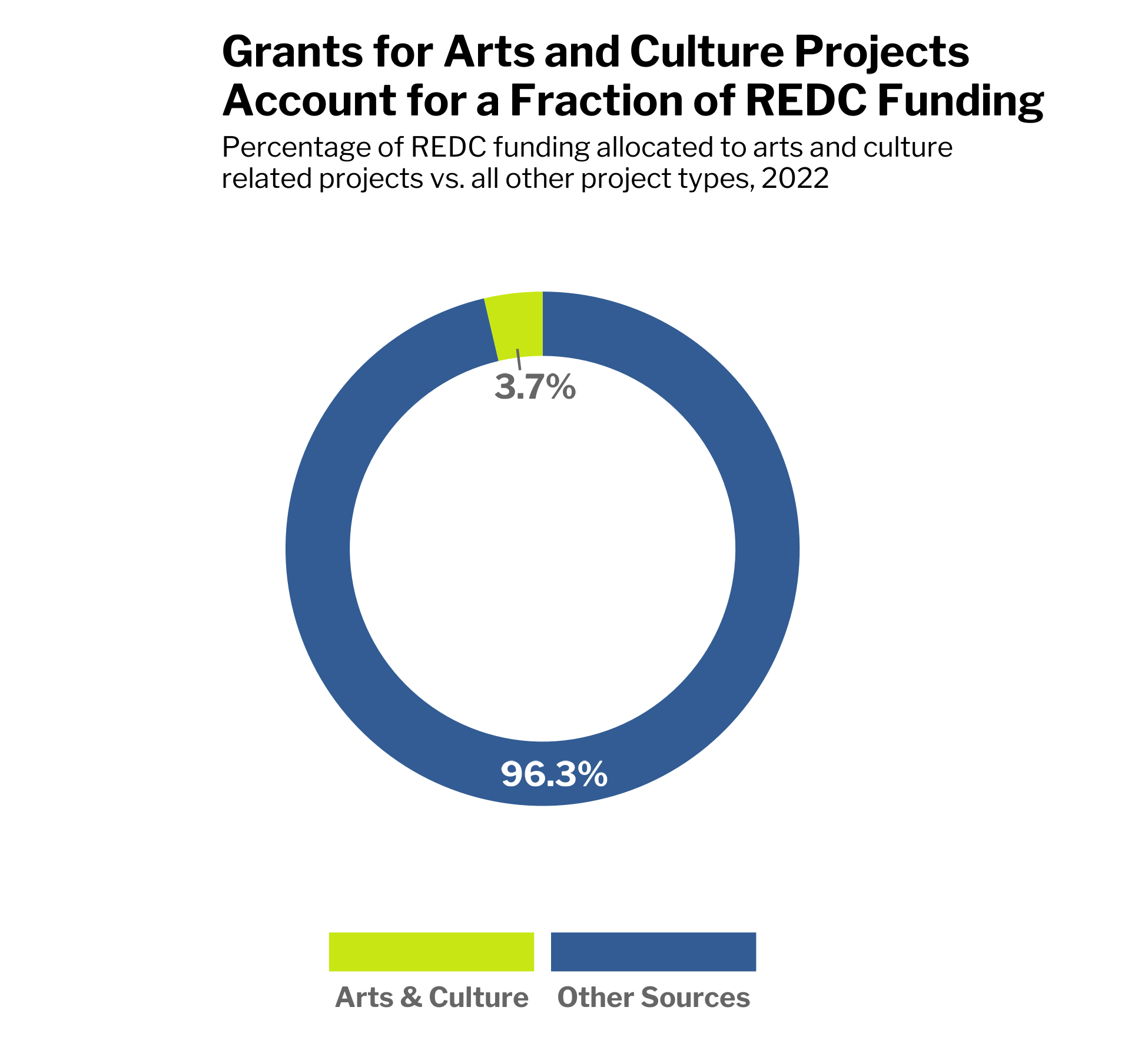
Seizing opportunities to link arts and inclusive economic development.
While arts-focused entities like NYSCA and the NEA will likely always be the main source of funding for artists and cultural organizations in New York, the state has missed out on opportunities to help supplement those dollars by using more of its economic development resources to support the arts. For example, while the creative sector has been a catalyst for economic growth upstate, the state’s Regional Economic Development Councils (REDCs) have too often overlooked the arts in their funding allocations. The arts and culture sector is poorly represented on REDC boards in upstate New York; of 227 total board members, only 4 are affiliated with the arts and culture sector.10 The lack of representation contributes to a funding system in which relatively few arts and culture projects break through. The Center for an Urban Future’s analysis reveals that only 3.7 percent of all REDC grants awarded in 2021 went to projects focused on arts and culture— $23.4 out of $639 million.
Similarly, only 12 out of the 104 Downtown Revitalization Initiative projects across all of New York State in 2022, or 11.5 percent, were focused on arts and culture. In the village of Perry in the Finger Lakes Region and the city of Dunkirk in Western New York, no DRI projects were related to arts and culture.
Policymakers have ample opportunity to integrate the arts into the broader statewide economic development strategy, including the REDCs, DRI, and Market New York—in addition to investing in stronger arts infrastructure like arts councils and arts districts, creating more affordable housing for artists, and helping arts organizations find permanent homes and achieve long-term financial stability. These and other policies have the potential to sustain the artists and arts organizations that make upstate New York such a vibrant place to live—and help lay the groundwork for stronger local communities and economies across every corner of the state.

Endnotes
1 This report defines the arts and culture sector as the performing arts, arts and culture venues, and independent artists, writers, and performers, including the following subgroups: art dealers, fine art schools, theater companies, dance companies, musical groups and artists, other performing arts companies, museums, historical sites, zoos and botanical gardens, and nature parks.
2 Center for an Urban Future analysis of data from Lightcast.
3 Center for an Urban Future analysis of data from the U.S. Census Bureau 2011 and 2021 American Community Survey 1-year estimates.
4 Center for an Urban Future analysis of data from NYSCA and NEA grant funding in all of New York State from 1998- 2022, available from https://apps.nea.gov/grantsearch.
5 Center for an Urban Future analysis of REDC awards, available from https://regionalcouncils.ny.gov. Center for an Urban Future analysis of Downtown Revitalization Initiative (DRI) awards from DRI round 6, available from https://www.ny.gov/downtown-revitalization-initiative/ dri-round-six-communities.
6 Center for an Urban Future analysis of data from the American Community Survey. This report uses the category of “art and design workers” as defined by the Bureau of Labor Statistics, which includes the following occupations: art directors, craft artists, fine artists, special effects artists and animators, all other artists and related workers, commercial and industrial designers, fashion designers, graphic designers, interior designers, merchandise displayers and window trimmers, set and exhibit designers, and all other designers.
7 Center for an Urban Future analysis of data from Lightcast.
8 Center for an Urban Future analysis of Tourism Economics traveler spending data from Empire State Development.
9 Center for an Urban Future analysis of NEA grant funding from 1998-2022.
10 Center for an Urban Future analysis of REDC board membership in New York’s economic state development regions with the exception of New York City and Long Island, “Regional Economic Development Council 2022 Annual Report,” https://regionalcouncils.ny.gov/

